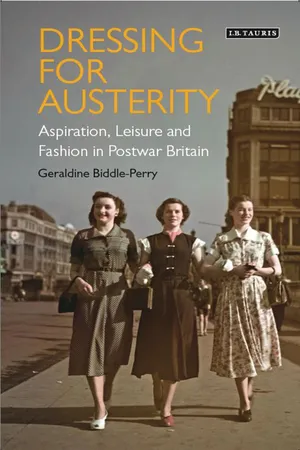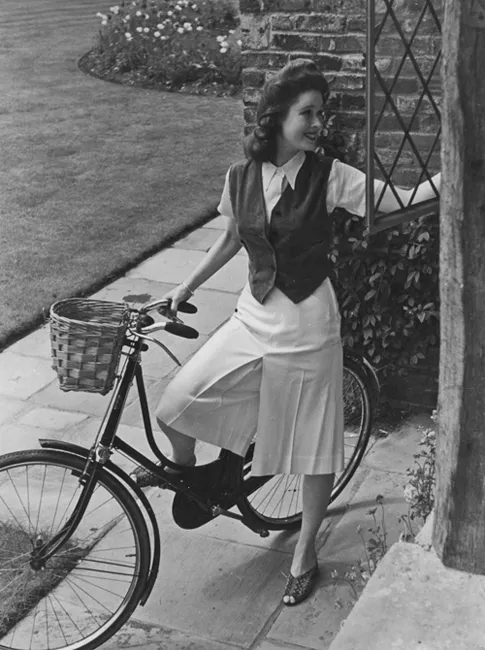![]()
A GIRL AND A BIKE
In June 1939, just prior to the outbreak of World War II, the popular illustrated magazine Picture Post features an attractive young female cyclist on its front cover. The young woman is carefully made up, her hair is fashionably waved and she wears shorts rolled up very short indeed with a matching collared shirt and tie (Fig. 1). The accompanying article, titled ‘A Day Awheel’, charts the activities of the Dulwich Paragon Cycling Club from South London, described as being made up of young men and women who, ‘like thousands of others all over Britain, leave behind the workaday streets … and make for the open country’.1 To illustrate the egalitarian nature of bicycling and the freedom to be found in a British countryside to be enjoyed by all, particular attention is paid to dress allied to new attitudes to leisure and fashionable consumption:
A little over six months later, Picture Post returned to the theme, but the rhetoric was transformed through a new discourse of equally healthy and fashionable comradely consumerism to now highlight how the ‘pre-war cult’ of cycling and its fashionable clothing might be used to advantage in wartime, especially by women. The recent raising of car tax and the introduction of petrol rationing meant thousands of people had been forced to garage their cars for the duration so that ‘soon the roads may be vivid with cycling lovelies wearing the most striking cycling kit ever seen’.3 Well-designed, practical split skirts, slacks and shorts favoured by young cyclists before the war were already exerting a visible influence on the models shown in the latest London collections, to which the well-cut chic of the West End added variety and sophistication. Of particular note were a ‘zipped “all-slacks” suit of camel hair and wool with a hooded jacket’ suggesting ‘a hint of the St Moritz holiday-maker … of the Finnish soldier’, and a more homespun practical suit in the ‘newest blue tweed’: a short Norfolk-style belted jacket with knee-length culottes co-ordinated with honey-coloured knitted stockings and jumper, finished off with a smart turban. Fashionable, functional, and appropriate for a variety of social contexts and locations, such clothing Picture Post suggests was ideal for wartime. It was not only country roads where bicycles and their fashionable young riders would now be seen:
This chapter explores this evolving sartorial landscape of patriotic fashionable innovation through a series of complex interactions between statutory and self-directed strategies of consumer constraint formulated and re-formulated throughout the war. The aim is to examine the fashion historical dimensions of clothing controls as a critical springboard to interrogating the concept of war and postwar austerity ‘by design’ (fashionable, cultural, political, and party political) as much as by material or legislative necessity. Geraldine Howell argues that ‘the story of wartime fashion is essentially the story of wartime controls’; her study carefully details the progressive introduction of clothes rationing, the Utility Clothing Scheme, and austerity restrictions and analyses the impact of a high-end British fashion industry on the distinctive wartime fashion aesthetic that evolved in response.5 The critical impetus of this study is to take up the ‘story’ in 1944 where Howell and other revisionist wartime fashion histories effectively come to an end – but that of wartime controls, and indeed the war itself, did not.
War in Europe ended in May 1945 and in the Far East a few months later in August but, as Christopher Sladen points out, clothing controls were part of a ‘utility patchwork’ of aesthetic, economic, material and ideological measures and piecemeal modifications in operation right up to 1951, the year before the orders governing them were finally annulled.6 The late-war period and plans for demobilisation arguably heralded not a release from, but a new chapter in the history of wartime controls, in their differentially gendered form and function, and in their political and moral justification. This chapter offers a new perspective on wartime controls and a shifting fashion aesthetic. Links between pre-war and wartime notions of modern citizenship embodied in fashion and style trends and popular leisure consumption formed the foundation of postwar socialist ambitions for the reconstruction. The introduction and nature of wartime clothing controls are outlined, not to provide another potted history of their mechanics but rather as a structuring device to lay out the critical ground for the chapters that follow. Austerity is problematised as a symbolic and material nexus of trade, designer, government and consumer responses and stimuli sustained by a discourse of patriotic citizenship that it was believed cut across previous boundaries of status recognition and signalled a new consensus on ‘fair shares’ when the war was over.
AUSTERITY BY (FASHIONABLE) DESIGN
At the outbreak of hostilities in 1939, there were initially plentiful stocks of clothing and raw materials, and although food rationing was introduced almost immediately (drawing on lessons learnt in World War I), various wartime ministries avoided taking responsibility for intervening in the workings of other manufacturing industries. Both Conservative leader and Prime Minister Neville Chamberlain and his successor Winston Churchill were averse to taking on a task seen as complicated and fraught with politico-philosophical difficulties.7 However, the rocketing cost of living impelled the introduction of price controls (November 1939) and then, as demand for affordable clothing and footwear rapidly outstripped supply, of the levying of Purchase Tax on clothing (October 1940) followed in March 1941 by the announcement of the first Making of Civilian Clothing [Restriction] Orders, commonly known as ‘austerity regulations’. These regulations proscribed limits on the design and making up of garments, for example, restricting the number of seams, pleats and buttonholes women’s coats might have and eliminating all non-essential decoration, embroidery, appliqué finishing and fur or leather trimmings.8 Two inches was also required to be removed from the bottom of men’s shirts and socks, ties and jackets shortened; trouser legs were narrowed and waist pleats, breast pockets and turn-ups banned, along with double-breasted jackets and double cuffs on shirts, and buttons were limited to three on jackets and waistcoats.9
Despite bureaucratic and philosophical misgivings, as the demands of war intensified so clothes rationing swiftly became a priority and legislation was rushed through in the summer of 1941. All adults, whatever their level of income, were allocated 66 coupons annually, issued at intervals throughout the year. Picture Post immediately responded with fashionable suggestions for ‘A Coupon Summer’: cotton trousers and dungarees ideal ‘for gardening, for cleaning, for washing clothes or bathing the baby’ or a new kind of ‘riding habit’ – a stylish ensemble of white culottes, matching blouse and scarlet bolero (Fig. 2).10 However, it was soon realised that while rationing was egalitarian in theory, the already materially comfortably off could use coupons merely to supplement well-stocked existing wardrobes. The Conservative MP Sir Henry ‘Chips’ Channon, for example, noted that, barring being bombed out, he possessed enough clothes to last for years; he was lucky enough to own at least 40 suits and foresaw that it was only maintaining a sufficient supply of socks that might prove difficult.11 To tip the balance in favour of those less well endowed and garner popular support for imminent further stringent restrictions as wartime production increased, in September 1941 the Utility Scheme controlling the manufacture of cloth and finished garments was introduced, coordinating coupon value with material yardage. The scheme was administered by the newly formed Civilian Clothing Directorate and was based on a number of complex acts and government orders that were regularly amended according to the changing conditions of militarism and fluctuations in the supply of raw materials, and in response to shifting consumer needs.12
The Board of Trade planned to work in partnership with manufacturers to ensure adequate provision and standardised quality of clothing and footwear for the lower end of the market and those in the most pressing need. Special releases of cloth were to be ‘made for the production of clothing of general utility’ to the Board’s precise specifications as to economy in materials and labour, in the durability and quality of cloth, and in costings. The application of the official mark CC41 (Civilian Clothing, 1941) would ensure that standards of production had been met.13 A limited range of 40 utility cloths of various types (wool, woven rayon, cotton, lock-knit) was initially produced and then, to improve and ensure consistent levels of quality and cater for differing needs and tastes, the scheme was progressively extended to include thousands of different and differently categorised types of fabric. Each of these was subject to Utility Specifications relating to weight of cloth, threads per warp and weft, the percentage of foreign matter that was included, the actual number of threads, the dye type and the maximum washing shrinkage per warp and weft.14
The Utility Scheme did not explicitly focus on issues of design but on simplifying production practices to reduce costs and conserve labour and materials. Speaking on the radio, Hugh Dalton referred to utility as supplying ‘standard’ clothing.15 This did little to endear the scheme to an already wary public. Key to the successful management of this raft of stringent measures controlling consumption patterns and choice was public compliancy and, by implication, the maintenance of consumer morale. In May 1942, therefore, Sir Cecil Weir of the Board of Trade invited leading London designers – Edward Molyneux, Charles Creed, Victor Steibel, Elspeth Champcommunal of Worth, Bianca Mosca, Hardy Amies, Peter Russell, Norman Hartnell and Digby Morton – to join together to provide a cohesive image and design aesthetic to promote utility fashion at home and British couture and garment and textile manufacturing abroad. The Incorporated Society of London Fashion Designers (IncSoc) was formed to build upon and further advance the growing reputation of London as an international centre of high quality fashion design and manufacture and increase the prestige of British couture overseas as a vital strand in the coalition’s wartime export drive.16
On the home front, IncSoc defined its role as:
IncSoc delegates met with Sir Thomas Barlow at the Board of Trade to discuss an ‘Outline for Utility Clothing’, with the aim of designing well with limited cloth, reducing the basic yardage per garment to 2.5 yards of 54-inch wide fabric and using simple seams and darts to minimise manufacturing processes.18 Utility style templates were produced in accordance with austerity regulations for a r...


